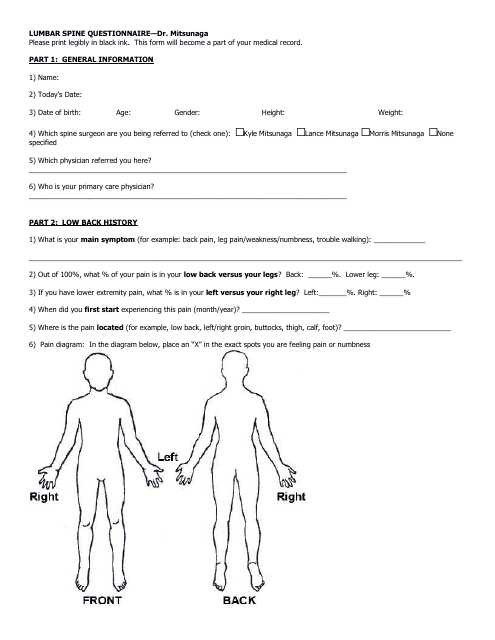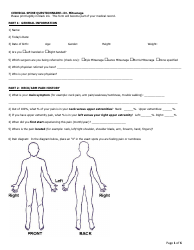Lumbar Spine Questionnaire
A Lumbar Spine Questionnaire is typically used by healthcare professionals to evaluate a patient's lower back pain. It collects information regarding the severity, frequency, and nature of the patient's pain, as well as how it affects their daily activities and quality of life. The collected data helps in diagnosing the cause of the pain, determining its impact, and devising a suitable treatment plan. It is an essential tool in the assessment, diagnosis, and clinical management of lumbar spine disorders.
The Lumbar Spine Questionnaire is typically filed by a medical professional or patient in order to evaluate the status of a patient's lumbar spine health. This could be a orthopedist, physical therapist, neurologist, or chiropractor. Patients might also fill it out during a health assessment or in preparation for an appointment, procedure or surgery relating to their lumbar spine. Please note the rules about patient's health documents handling may vary based on country and region due to different healthcare and privacy laws.
FAQ
Q: What is the lumbar spine?
A: The lumbar spine refers to the lower part of your spine, it is composed of five vertebrae which are designated as L1 - L5. These vertebrae are larger than the upper spinal vertebrae as they need to support more of your body's weight and provide motion.
Q: What is the function of the lumbar spine?
A: The lumbar spine primarily functions to bear the weight of the body. It also provides mobility for movements such as twisting and bending.
Q: What is a lumbar spine questionnaire?
A: A lumbar spine questionnaire is a health assessment tool often used by doctors or physical therapists to evaluate a patient's lower back pain or disability. It typically includes questions about the intensity, frequency, and nature of the pain, as well as how it affects daily activities.
Q: Why is a lumbar spine questionnaire used?
A: The lumbar spine questionnaire is used to evaluate the patient's condition and track changes over time. It helps healthcare providers determine the impact of the pain on the individual's daily life and guides the treatment plan.
Q: What conditions can affect the lumbar spine?
A: Conditions that can affect the lumbar spine include herniated disc, spinal stenosis, degenerative disc disease, spondylolisthesis, lumbar radiculopathy, and osteoarthritis among others.
Q: What does degeneration of the lumbar spine mean?
A: Degeneration of the lumbar spine, also known as lumbar spondylosis, refers to a condition that is more common as people age. It's characterized by the loss of normal structure and function of the lumbar vertebrae from wear and tear.
Q: What are the treatments for lumbar spine conditions?
A: Treatments for lumbar spine conditions vary depending on the severity and type of condition. They can range from physical therapy and pain management techniques, to medications, to surgical interventions in more serious cases.











